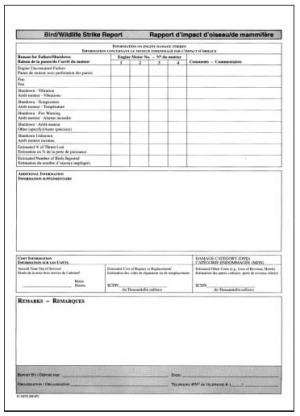Introduction
The geographic location of bird and mammal strikes determines how and where reports are filed. As this book concerns primarily North American jurisdictions, this Appendix concentrates on Canadian and American bird- and mammal-strike reporting procedures.
Recognizing that aviation is a worldwide activity, we have suggested a general process to report international bird and mammal strikes. In the event of a strike, however, aircraft operators and pilots should contact the governing aviation regulatory body to determine proper reporting procedures.
Figure C.1 illustrates the process for reporting bird and mammal strikes in Canada, the U.S. and abroad.
Who should report a bird or wildlife strike?
Since effective wildlife-strike measures result from the analysis of available strike reports, it is imperative that all bird- and mammal-strike events are reported by:
- airport managers,
- wildlife-management personnel,
- airfield workers,
- airport wildlife-management committees,
- air-traffic service providers,
- pilots,
- aircraft-maintenance personnel,
- aircraft operators,
- flight-safety personnel, and
- any other person who finds evidence of a bird or wildlife strike.
Figure C.1 — Wildlife Strike Reporting Process
Reporting authorities
Wildlife-strike reporting forms are available from and should be forwarded to the following organizations:
Canada
Wildlife Control Specialist
Transport Canada
Aerodromes and Air Navigation Branch
330 Sparks Street
Place de Ville, Tower C, 7th floor
Ottawa, Ontario
K1A 0N8
Tel: (613) 990-4869
Fax: (613) 954-1602
Toll-free Bird/Wildlife Strike Reporting line: 1-888-282-BIRD (In Canada only)
E-mail: WildlifeControl-Controledelafaune@tc.gc.ca
Internet home page: https://tc.canada.ca/en/aviation/operating-airports-aerodromes/controlling-wildlife-near-airports-aerodromes
United States
FAA Office of Airports
800 Independence Avenue SW
Room 600E
Washington, DC 20591
Courriel : ryan.king@faa.gov
Page Internet : http://wildlife-mitigation.tc.faa.gov/wildlife/default.aspx
Tel: (202) 267-3389
Fax: (202) 267-5383
Email: ed.cleary@faa.gov
Internet home page: https://tc.canada.ca/en/aviation/operating-airports-aerodromes/controlling-wildlife-near-airports-aerodromes
Transport Canada Bird/Wildlife Strike Report Form.
U.S. Department of Transportation Bird/Wildlife Strike Report Form.
Directions for FAA Form 5200-7 — Bird/Other Wildlife Strike Report
- Name of Operator — This can be an airline (abbreviations okay — UAL, AAL, etc.), business (Coca Cola), government agency (Police Dept., FAA) or if a private pilot, his or her name.
- Aircraft Make/Model — Abbreviations are okay, but try to include the model (e.g., B737-200).
- Engine Make/Model — Abbreviations are allowed (e.g., PW 4060, GECT7, LYC 580).
- Aircraft Registration — This means the N# (for USA registered aircraft).
- Date of Incident — Give the local date, not the ZULU or GMT date.
- Local Time of Incident — Check the appropriate light conditions and fill in the hour and minute local time and check AM or PM or use the 24 clock and skip AM/PM.
- Airport Name — Use the airport name or 3 letter code if a US airport. If a foreign airport, use the full name or 3 letter code and location (city/country).
- Runway used — Self explanatory.
- Location if En Route — Put the name of the nearest city and state.
- Height AGL — Put the feet above ground level at the time of the strike (if you don’t know, use MSL and indicate this). For take-off run and landing roll, it must be 0.
- Speed (IAS) — Speed at which the aircraft was traveling when the strike occurred.
- Phase of Flight — Phase of flight during which the strike occurred. Take-off run and landing roll should both be 0 AGL.
- Part(s) of Aircraft Struck or Damaged — Check which parts were struck and damaged. If a part was damaged but not struck, indicate this with a check on the damaged column only and indicate in comments (#21) why this happened (e.g., the landing gear might be damaged by deer strike, causing the aircraft to flip over and damage parts not struck by deer).
- Effect on Flight — You can check more than one and if you check “Other”, please explain in Comments (#21).
- Sky Condition — Check the one that applies.
- Precipitation — You may check more than one.
- Bird/Other Wildlife Species — Try to be accurate. If you don’t know, put unknown and some description. Collect feathers or remains for identification for damaging strikes.
- Number of birds seen and/or struck — Check the box in the Seen column with the correct number if you saw the birds/other wildlife before the strike and check the box in the Struck column to show how many were hit. The exact number, can be written next to the box.
- Size of Bird(s) — Check what you think is the correct size (e.g. sparrow = small, gulls = medium and geese = large).
- Pilot Warned of Birds — Check the correct box (even if it was an ATIS warning or NOTAM).
- Remarks — Be as specific as you can. Include information about the extent of the damage, injuries, anything you think would be helpful to know. (e.g., number of birds ingested).
- Aircraft time out of service — Record how many hours the aircraft was out of service.
- Estimated cost of repairs or replacement — This may not be known immediately, but the data can be sent at a later date or put down a contact name and number for this data.
- Estimated other cost — Include loss of revenue, fuel, hotels, etc. (see directions for #23).
- Reported by — Although this is optional, it is helpful if questions arise about the information on the form (a phone number could also be included).
- Title — This can be Pilot, Tower, Airport Operations, Airline Operations, Flight Safety, etc.
- Date — Date the form was filled out.



